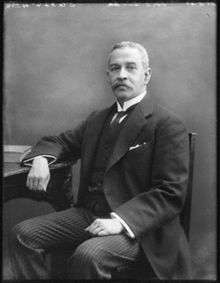Satyendra Prasanno Sinha, 1st Baron Sinha
| The Right Honourable The Lord Sinha KCSI, PC, KC | |
|---|---|
 A whole-plate glass negative portrait of Satyendra Prasanno Sinha taken by Bassano Ltd, 20 May 1920, and now in the collection of the National Portrait Gallery, London. | |
| Personal details | |
| Born |
24 March 1863 Raipur, Birbhum, Bengal |
| Died |
4 March 1928 Berhampore, Bengal |
| Spouse(s) | Gobinda Mohini Sinha (nee Mitter) |
| Occupation | Politician, lawyer |
Satyendra Prasanno Sinha, 1st Baron Sinha, KCSI, PC, KC, (24 March 1863 – 4 March 1928) was a prominent lawyer and statesman in British India.
Background and education
Satyendra Prasanno Sinha was born on 24 March 1863 in Raipur, Birbhum in Bengal, British India. His father was a zamindar of the Kayastha caste. He was educated first in Bibhum Zilla School at Suri and then obtained a scholarship to Presidency College, Calcutta, then an affiliate of the University of Calcutta, in 1878. He married Gobinda Mohini Mitter on 15 May 1880 at Mahata, Burdwan, Bengal, and in 1881 he abandoned his studies in India to study law in England. Scholarships and prizes enabled him to attend Lincoln's Inn and in 1886 he returned to Calcutta as a barrister.[1]
Career
After returning to India in 1886, Sinha established a successful legal practice in Calcutta. He was a member of the Indian National Congress from 1896 to 1919, when, along with other moderates, he left the organisation. He was elected to preside over the Bombay session of the Congress in 1915.
Sinha became Standing Counsel to the Government of India in 1903. He was the first Indian to be appointed as Advocate-General of Bengal in 1908, and the first Indian member of the Governor-General's Executive Council in 1909. He went to England in 1914 as a member of the War Conference following the outbreak of the First World War, and represented India in Europe's Peace Conference in 1919.
He was knighted in the New Year Honours on 1 January 1915. He was the first Indian to be appointed as Parliamentary Under-Secretary of State for India in 1919. In the same year he was elevated to the peerage as Baron Sinha of Raipur in the Presidency of Bengal, becoming the first Indian member of the British House of Lords, taking his seat in February 1919. After his ennoblement, he navigated a bill through the House of Lords, which became the Government of India Act 1919; the Act transferred legislative power from the Viceroy of India to an Indian Legislature as a step towards self-government. Lord Sinha also became a member of the Imperial Privy Council.
He became Governor of the Privince of Bihar and Orissa in 1920, the first Indian to be appointed to such a high rank in the administration of British India. However, in 1921 he retired on the grounds of ill health. In 1926 he became a member of the Judicial Committee of the Privy Council.
Sinha died on 4 March 1928 at Berhampore. He and his wife had seven children.[1]
Styles
- 1863–1886: Satyendra Prasad Sinha
- 1886–1915: Satyendra Prasad Sinha, KC
- 1915-10 February 1919: Sir Satyendra Prasad Sinha, KC
- 10–19 February 1919: The Right Honourable Sir Satyendra Prasad Sinha, PC, KC
- 19 February 1919 – 1920: The Right Honourable The Lord Sinha, PC, KC
- 1920-1921: His Excellency The Right Honourable The Lord Sinha, PC, KC
- 1921–1928: The Right Honourable The Lord Sinha, KCSI, PC, KC
Notes
- 1 2 FitzGerald, S. V. (2004). "Sinha, Satyendra Prasanno, first Baron Sinha (1863–1928)". revised Raychaudhuri, Tapan. Oxford Dictionary of National Biography, Oxford University Press. Retrieved 18 August 2013. (subscription or UK public library membership required)
External links
- Biographies:
- Ali, Muhammad Ansar (2012). "Sinha, Lord Satyendra Prasanna". In Islam, Sirajul; Jamal, Ahmed A. Banglapedia: National Encyclopedia of Bangladesh (Second ed.). Asiatic Society of Bangladesh.
- Portraits at the National Portrait Gallery
| Political offices | ||
|---|---|---|
| Preceded by B.N. Bose |
President of the Indian National Congress 1915–1916 |
Succeeded by Ambica Charan Mazumdar |
| Political offices | ||
| Preceded by The Lord Islington |
Under-Secretary of State for India 1919–1920 |
Succeeded by The Earl of Lytton |
| Political offices | ||
| Preceded by New office (Sir Edward Gait as Lieutenant Governor) |
Governor of Bihar and Odisha 1920–1921 |
Succeeded by Havilland Le Mesurier (acting) |
| Peerage of the United Kingdom | ||
| Preceded by New creation |
Baron Sinha 1919–1928 |
Succeeded by Aroon Kumar Sinha |